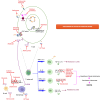Update on non-infectious uveitis treatment: anti-TNF-alpha and beyond
- PMID: 39157460
- PMCID: PMC11327136
- DOI: 10.3389/fopht.2024.1412930
Update on non-infectious uveitis treatment: anti-TNF-alpha and beyond
Abstract
Non-infectious uveitis (NIU) encompasses a range of conditions marked by inflammation within various layers of the eye. NIU is a significant contributor to irreversible vision loss among the working-age population in developed countries. The aim of treating uveitis is to manage inflammation, prevent its recurrences and to restore or salvage vision. Presently, the standard treatment protocol for NIU involves initiating corticosteroids as the primary therapeutic agents, although more aggressive approaches and steroid sparing agent may be necessary in certain cases. These advanced treatments option include synthetic immunosuppressants like antimetabolites, calcineurin inhibitors and alkylating agents. For patients who exhibit an intolerance or resistance to corticosteroids and conventional immunosuppressive therapies, biologic agents have emerged as a promising alternative. Notably, among the biologic treatments evaluated, TNF-α inhibitors, anti-CD20 therapy and alkylating agents have shown considerable efficacy. In this review, we delve into the latest evidence surrounding the effectiveness of biologic therapy and introduce novel therapeutic strategies targeting immune components as potential avenues for advancing treatment of NIU.
Keywords: ACTH analogues; JAK inhibitors; PDE-4 inhibitors; TNF alpha inhibitors; interleukin inhibitors; mTOR inhibitors; non-infectious uveitis (NIU); rituximab.
Copyright © 2024 Chauhan and Tyagi.
Conflict of interest statement
The authors declare that the research was conducted in the absence of any commercial or financial relationships that could be construed as a potential conflict of interest.
Figures
Similar articles
-
New Pharmacological Strategies for the Treatment of Non-Infectious Uveitis. A Minireview.Front Pharmacol. 2020 May 8;11:655. doi: 10.3389/fphar.2020.00655. eCollection 2020. Front Pharmacol. 2020. PMID: 32508634 Free PMC article. Review.
-
Biotherapies in Uveitis.J Clin Med. 2020 Nov 8;9(11):3599. doi: 10.3390/jcm9113599. J Clin Med. 2020. PMID: 33171664 Free PMC article. Review.
-
Perspectives for immunotherapy in noninfectious immune mediated uveitis.Expert Rev Clin Immunol. 2021 Sep;17(9):977-989. doi: 10.1080/1744666X.2021.1956313. Epub 2021 Jul 26. Expert Rev Clin Immunol. 2021. PMID: 34264142 Review.
-
Update on the systemic management of noninfectious uveitis in children and adolescents.Surv Ophthalmol. 2024 Jan-Feb;69(1):103-121. doi: 10.1016/j.survophthal.2023.01.002. Epub 2023 Jan 19. Surv Ophthalmol. 2024. PMID: 36682467 Review.
-
New therapies in development for the management of non-infectious uveitis: A review.Clin Exp Ophthalmol. 2019 Apr;47(3):396-417. doi: 10.1111/ceo.13511. Clin Exp Ophthalmol. 2019. PMID: 30938012 Review.
Cited by
-
Nanomedicine-Based Ophthalmic Drug Delivery Systems for the Treatment of Ocular Diseases.Int J Nanomedicine. 2025 Jul 21;20:9221-9249. doi: 10.2147/IJN.S532074. eCollection 2025. Int J Nanomedicine. 2025. PMID: 40718639 Free PMC article. Review.
-
Role of CD4+ T cell-derived cytokines in the pathogenesis of uveitis.Clin Exp Med. 2025 Feb 5;25(1):49. doi: 10.1007/s10238-025-01565-7. Clin Exp Med. 2025. PMID: 39909966 Free PMC article. Review.
-
Real-world treatment patterns for patients with non-infectious uveitis in Japan: a descriptive study using a large-scale claims database (J-CAT study).J Ophthalmic Inflamm Infect. 2025 Jul 22;15(1):56. doi: 10.1186/s12348-025-00514-5. J Ophthalmic Inflamm Infect. 2025. PMID: 40694217 Free PMC article.
References
-
- Gamalero L, Simonini G, Ferrara G, Polizzi S, Giani T, Cimaz R. Evidence-based treatment for uveitis. Isr Med Assoc J. (2019) 21:475–9. - PubMed
Publication types
LinkOut - more resources
Full Text Sources
Miscellaneous


